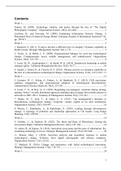Contents
Week 1:.......................................................................................................................................3
Tripsas, M. (2009). Technology, identity, and inertia through the lens of “The Digital
Photography Company”. Organization Science, 20(2), 441-460................................................3
Lyytinen, K., and Newman, M. (2008). Explaining Information Systems Change: A
Punctuated Socio-Technical Change Model, European Journal of Information Systems(17:6),
pp. 589-613.................................................................................................................................4
Week 2:.......................................................................................................................................7
1. Danneels, E. (2011). Trying to become a different type of company: Dynamic capability at
Smith Corona. Strategic Management Journal, 32(1), 1-31........................................................7
2. Taylor, A., & Helfat, C. E. (2009). Organizational linkages for surviving technological
change: Complementary assets, middle management, and ambidexterity. Organization
Science, 20(4), 718-739..............................................................................................................8
3. Lewis, M. W., Andriopoulos, C., & Smith, W. K. (2014). Paradoxical leadership to enable
strategic agility. California Management Review, 56(3), 58-77...............................................10
4. Anand, J., Oriani, R., & Vassolo, R. S. (2010). Alliance activity as a dynamic capability in
the face of a discontinuous technological change. Organization Science, 21(6), 1213-1232...11
Week 3:.....................................................................................................................................12
5. Gerstner, W. C., König, A., Enders, A., & Hambrick, D. C. (2013). CEO narcissism,
audience engagement, and organizational adoption of technological discontinuities.
Administrative Science Quarterly, 58(2), 257-291...................................................................12
6. Vuori, T. O., & Huy, Q. N. (2022). Regulating top managers’ emotions during strategy
making: Nokia’s socially distributed approach enabling radical change from mobile phones to
networks in 2007–2013. Academy of Management Journal, 65(1), 331-361...........................13
7. Maula, M. V., Keil, T., & Zahra, S. A. (2013). Top management’s attention to
discontinuous technological change: Corporate venture capital as an alert mechanism.
Organization Science, 24(3), 926-947......................................................................................16
8. Morais, F., Kakabadse, A., & Kakabadse, N. (2020). Leading through discontinuous
change: A typology of problems and leadership approaches in UK boards. Long Range
Planning, 53(2), 101870............................................................................................................17
Week 4:.....................................................................................................................................18
9. Goldsby, C., & Hanisch, M. (2022). The Boon and Bane of Blockchain: Getting the
Governance Right. California Management Review, 64(3), 141-168......................................18
10. Adner, R., & Kapoor, R. (2016). Innovation ecosystems and the pace of substitution: Re‐
examining technology S‐curves. Strategic Management Journal, 37(4), 625-648...................20
11. Benner, Mary. J. (2010). Securities analysts and incumbent response to radical
technological change: Evidence from digital photography and internet telephony.
Organization Science, 21(1), 42-62..........................................................................................22
12. Maslach, D. (2016). Change and persistence with failed technological innovation.
Strategic Management Journal, 37(4), 714-723........................................................................23
Week 5:.....................................................................................................................................24
1
,13. Ahuja, M. K., & Thatcher, J. B. (2005). Moving beyond intentions and toward the theory
of trying: Effects of work environment and gender on post-adoption information technology
use. MIS Quarterly, 427-459.....................................................................................................24
14. Lapointe, L., & Rivard, S. (2005). A Multilevel Model of Resistance to Information
Technology Implementation. MIS Quarterly (29:3), pp. 461-491............................................25
15. Bagayogo, F. F., Lapointe, L., & Bassellier G. 2014. “Enhanced use of IT: A new
perspective on Post-Adoption. Journal of the Association for Information Systems, 15(7):
361-387.....................................................................................................................................27
16. Zhu, K., & Kraemer, K. L. (2005). Post-adoption variations in usage and value of e-
business by organizations: cross-country evidence from the retail industry. Information
Systems Research, 16(1), 61-84................................................................................................30
2
, Week 1:
Tripsas, M. (2009). Technology, identity, and inertia through the lens of “The Digital
Photography Company”. Organization Science, 20(2), 441-460.
The article by Tripsas (2009) examines the dynamics of technology, identity, and inertia in
the context of a case study of a digital photography company. The author uses a theoretical
framework that draws on the concept of technological trajectory and identity to explain why
the company struggled to adapt to changes in the market.
The research question that the author seeks to answer is how technological identity affects a
firm's ability to adapt to changes in the market. The author uses the case of the digital
photography company to examine the impact of technological trajectory and identity on the
firm's inertia and its ability to innovate.
The article discusses how the digital photography company was initially successful in the
market due to its focus on digital technology. However, as the market evolved, the company
failed to adapt, and its sales declined. The author argues that the company's technological
identity, which was closely tied to digital technology, led to inertia and prevented it from
exploring alternative technological trajectories. The article also discusses the role of external
pressures, such as market competition and technological change, in shaping the company's
identity and its ability to innovate.
The conclusion of the article emphasizes the importance of understanding the relationship
between technology and identity in shaping firms' strategic decisions. The author argues that
firms need to be aware of the potential for inertia and the importance of exploring alternative
technological trajectories to avoid becoming obsolete in rapidly changing markets. The article
also highlights the need for firms to be proactive in shaping their identities and adapting to
external pressures to remain competitive.
Technological trajectory: This concept refers to the path of technological development
that a firm follows. It involves the specific technologies and components that are used
in the production of goods or services, as well as the practices and processes
associated with them.
Technological identity: This concept refers to the set of beliefs, values, and practices
that a firm associates with its technological trajectory. It involves the firm's self-image
and the way it presents itself to the market in terms of its technological capabilities.
Inertia: Inertia refers to the tendency of firms to continue following their existing
trajectory, even in the face of changing market conditions or technological
developments. Inertia can lead to missed opportunities and the failure to adapt to
changing circumstances.
Innovation: Innovation refers to the development and introduction of new products,
processes, or services that are novel and useful. It involves the ability of firms to
explore alternative technological trajectories and adapt to changing market conditions.
External pressures: External pressures refer to the forces that shape a firm's strategic
decisions from outside the organization. They include factors such as market
competition, technological change, and regulatory or legal changes that affect the
firm's ability to operate and compete in the market.
3




